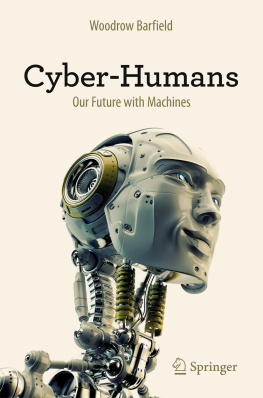Introduction
Let me start the book with a controversial and bold statementour future is to merge with artificially intelligent machines! How I reached that conclusion is the subject of this book. I dont mean to imply that in the coming decades we humans will look and act like robots on an assembly line, rather, that we will be equipped with so much technology, including computing devices implanted within the brain itself, that we will have been transformed from a biological being into a technology-based being, evolving under laws of technology, more so than under the laws of biological evolution. At the same time that we are becoming more machine like (or cyborg like), advances in robotics, artificial intelligence, neuroscience, and materials engineering are allowing scientists to create intelligent machines that have sophisticated humanlike functionality and are rapidly gaining in intelligencethey are becoming like us. I see the logical outcome of technological advancements in robotics, artificial intelligence, prosthesis, and brain implants, as a future merger between humans and machines. This will not be a conscious decision made by humanity, but will be a gradual process, and inevitable. But not so gradual as to take centuries, but in all likelihood something that will happen this century or early next.
As a confession, I may have played a small role in this outcome (our future merger with machines), because as a faculty in engineering, I headed a research laboratory whose goal was to design wearable computing and sensor technology that was fully integrated with the human body. In the early 1990s, I began to formalize my thinking about the future direction of technology, and wrote about it in 2001, in a chapter 1 co-authored, Computing Under the Skin , in which my colleagues and I argued for the use of sensors and cyborg implants to fix, repair, replace, and enhance damaged human anatomical and physiological systems. At the time, my colleagues and I also mused about the future directions of wearable devices, making predictions about technology that are being implemented today. But in hindsight, it seems that we didnt go far enough predicting the future that has unfolded and we were too conservative in stating how close we are to the Singularity and afterwards Posthuman age.
Much of my work on the design and use of wearable technology was published in two books I co-edited, Virtual Environments and Advanced Interface Design, and Fundamentals of Wearable Computers and Augmented Reality. Since the publication of the first edition of these books over a decade ago, the landscape in human enhancement technology and artificial intelligence has changed dramatically. To address these changes, I wrote this book to present an up-to-date summary of recent advances in genetics, prosthesis, and brain-computer interfaces; and to discuss current efforts to create artificially intelligent machines that learn and solve problems in ways not predicted by humans. Another goal in writing this book was to generate discussion among the public on the law and policies which should be enacted as humans are enhanced by technology, and as artificially intelligent machines gain human, or beyond human, levels of intelligence. Given the nature of the topics presented in this book, the discussion will be wide ranging cutting across diverse fields such as biology, engineering, ethics, and law.
As often stated by Googles Ray Kurzweil, the rate of technological change in engineering, medicine, and computer science is accelerating. sees a cyborg future for humanity which includes implantations of silicon chips into the human brain modified with DNA. Fast forward to Professor Theodore Bergers laboratory at the University of Southern California, where our cyborg future is being designed now in the form of remarkable neuroprosthetic devices.
Enhancing Humans
According to Sidney Perkowitz writing in Digital People: From Bionic Humans to Androids, there are two main ways to categorize artificial enhancements of humans: firstly, as functional prosthetic devices and implants, such as artificial limbs, replacement knees and hips, and vascular stents (which aid in the flow of blood in blocked arteries); and secondly, as cosmetic or vanity implants, like hair plugs, false teeth, artificial eyes, and breast implants. This book concerns both categories of enhancements, and it is interesting to note that the efforts of some researchers to develop human-like robots, could be thought of as cosmetic or vanity enhancements to the machine, as such enhancements may be nonfunctional. Enhancement technologies may also occur in a multitude of ways, supported by a variety of technologies, in which human beings enhance their looks, abilities, features, or functions. In fact, enhancements to the human body range from performance enhancing drugs, plastic surgery and silicone implants for (perceived) beauty purposes, to bionic limbs and chip-enhanced cognition in humans. While the distinguishing feature of cyborg enhancement technology is to improve human functioning above normal or average, many technologies for enhancement are being used for medical or regenerative purposes; for example, plastic surgery for burn victims or prostheses for lost limbs; the purpose in these cases being to bring the people back to normal.
In addition to efforts to enhance the human body with a range of technologies, other important progress is being made in robotics and artificial intelligence that is also setting the stage for a human-machine merger. Due to major improvements in algorithms and sensors, machines are becoming more autonomous, software is becoming smarter, and robots are being developed that are beginning to look and act more like humans than machines (see Chaps.
The vision of a future world populated by humans, cyborgs, intelligent robots, and androids raises many interesting questions. One such question is what this development means for fundamental or constitutional rights for the range of intelligent beings that may exist in the near future. Will cyborgs be considered human enough to still be bearers of human rights? Can androids claim human rights if they look and function in the same way in society as humans or cyborgs? And can human beings keep robots under control as they become increasingly autonomous; in other words, will robots comply with Asimovs three laws of robotics, or will they, like HAL in 2001 A Space Odyssey , revolt and try and control humans? Society has been warned of this very outcome by physicist Stephen Hawking and entrepreneur and CEO of Telsa Motors Elon Musk. Now suppose that robots and artificially-intelligent machines perform similar functions as cyborgs do, and perhaps even become androids who are in looks and functions equivalent to cyborgs, then should they not have the same catalogue of rights? This issue will require substantial debate in society and legal academia.
Another issue that technologically enhanced people may raise is whether a social, or digital divide will develop between enhanced and non-enhanced humans. Human rights can play an important part in this debate: because they lay down the basic rules for treating people. At first sight, the right to non-discrimination will provide substantial guidance: non-enhanced people should not be treated unequally. However, what is unequal, if in the future enhanced humans are different in important ways from non-enhanced humans? For example, if an employer can choose between an unenhanced person with an IQ of 120 and a cyborg with an IQ of 260 or beyond, does he discriminate if he chooses the cyborg? This is just one example of questions concerning specific human rights in relation to human enhancement that merit public debate.










